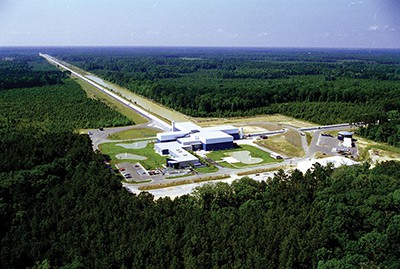
A $200m upgrade to the Laser Interferometer Gravitational-wave Observatory (LIGO) has been completed, with the facility set for observations in the coming months as it aims to be the first to detect a gravitational wave. Dubbed Advanced LIGO, it consists of two separate telescopes in the US – the Livingston observatory in Louisiana and the Hanford observatory in Washington state – that use laser interferometers to search for gravitational waves.
According to Einstein’s general theory of relativity, gravitational waves are effectively ripples in space–time that travel as a wave. While none have ever been directly detected, scientists have observed a loss of energy as two neutron stars – the dense cores of once-massive stars – spiral toward each other. That energy loss is precisely what Einstein’s equations predict would be emitted as gravitational radiation.
Twice as good
The Advanced LIGO observatories each have two 4 km-long arms perpendicular to each other. At the vertex lie a laser and a beam splitter, which sends light down each arm. The light bounces off mirrors at the end of each identical-length arm, before returning to the vertex and combining. A nearby detector usually receives no light, but if a gravitational wave passes through the observatory, the arm lengths should change slightly, meaning that the detector will see a signal.
LIGO began operations in 2001, and closed down in 2010 to start the upgrade programme. “Advanced LIGO is a complete rebuild of the interferometers of the detector,” says David Reitze of the California Institute of Technology, who is executive director of the LIGO Laboratory. “If they were cars, we traded in our 2001 LIGO sports car for the 2015 version.”
First data from Advanced LIGO are expected in September, with the facility running at about one-third of its final sensitivity. It will take a few years for Advanced LIGO to reach that level, which will make it 10 times more sensitive than the original observatory. Gabriela González, the LIGO Scientific Collaboration spokesperson, says the team predicts that Advanced LIGO will detect gravitational waves even before that full sensitivity is reached.
- Watch the video below, from the American Museum of Natural History, to find out more about gravitational waves and how LIGO plans to measure them



